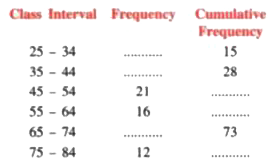Complete Solutions to EXERCISE 18 (A) of chapter STATISTICS of Class 9 book with complete answers and questions
| Class 9 | MATHS |
| Chapter | STATISTICS |
| SELINA PUBLICATION | EXERCISE 18 (A) |
| Number Of Questions | 21 |
| Academic Year | 2023-24 |
State, which of the following variables are continuous and which are discrete :
number of children in your class.
View SolutionState, which of the following variables are continuous and which are discrete :
distance travelled by a car.
View SolutionState, which of the following variables are continuous and which are discrete :
sizes of shoes.
View SolutionState, which of the following variables are continuous and which are discrete :
time.
View SolutionState, which of the following variables are continuous and which are discrete :
number of patients in a hospital.
View SolutionGiven below are the marks obtained by 30 students in an examination :
`{:(08,17,33,41,47,23,20,34,09,18,42,14,30),(19,29,11,36,48,40,24,22,02,16,21,15,32),(47,44,33,01,,,,,,,,,):}`
Taking class intervals 1-10, 11-20 ,......, 41 - 50 , Make a frequency table for the above distribution.
View SolutionThe marks of 24 candidates in the subject mathematics are given below :
`{:45, 48, 15, 23 ,30 ,35, 40, 11,29, 0 ,3 ,12, 48 ,18 ,30,15 ,30, 1, 1, 42, 23, 2 ,3 ,44:}`
The maximum marks are 50. Make a frequency distribution taking class intervals 0 - 10, 10 - 20, ...............
View SolutionFill in the blanks : (a) A quantity which can vary from one individual to another is called a ............. (b) Sizes of shoes are ............... variables. (c) Daily temperature is ............... variable. (d) The range of the data 7, 13, 6, 25, 18, 20, 16 is ................(e) In the class interval 35 - 46, the lower limit is .............and upper limit is ........... (f) The class mark of class interval 22 - 29 is ...............
View SolutionFind the actual lower class limits , upper class limits and mid values of the classes :
10 -19 , 20 - 29 , 30 - 39 , and 40 - 49
View SolutionFind the actual lower and upper class limits and also the class marks of the classes :
1.1 - 2.0, 2.1 - 3.0 and 3.1 - 4.0.
View SolutionUse the table given below to find : (a) The actual class limits of the fourth class. (b) The class boundaries of the sixth class. (c) The class mark of the third class. (d) The upper and lower limits of the fifth class. (e) The size of the third class.
`{:("Class interval","Frequency"),(30-34,7),(35-39,10),(40-44,12),(45-49,13),(50-54,8),(55-59,4):}`
View SolutionConstruct a cumulative, frequency distribution table from the frequency table given below :
`{:("Calss Interval","Frequency"),(0-8,9),(8-16,13),(16-24,12),(24-32,7),(32-40,15):}`
View SolutionConstruct a cumulative frequency distribution table from the frequency table given below :
`{:("Calss Interval","Frequency"),(1-10,12),(11-20,18),(21-30,23),(31-40,15),(41-50,10):}`
View SolutionConstruct a frequency distribution table from the following cumulative frequency distribution :
`{:("Calss Interval","Cumulative Frequency"),(10-19,8),(20-29,19),(30-39,23),(40-49,30):}`
View SolutionConstruct a frequency distribution table from the following cumulative frequency distribution :
`{:("Calss Interval","Frequency"),(5-10,18),(10-15,30),(15-20,46),(20-25,73),(25-30,90):}`
View SolutionConstruct a frequency table from the following data
`{:("Marks","No of students"),("less than" 10,6),("less than" 20,15),("less than" 30,30),("less than" 40,39),("less than" 50,53),("les than" 60,70):}`
View SolutionConstruct the frequency distribution table from the following cumulative frequency table:
`{:("Ages" ,"No of Students"),("Below" 4,0),("Below" 7,85),("Below" 10,140),("Below" 13,243),("Below" 16,300):}`
State the number of students in the age group 10-13
View SolutionConstruct the frequency distribution table from the following cumulative frequency table:
`{:("Ages" ,"No of students"),("Below" 4,0),("Below" 7,85),("Below" 10,140),("Below" 13,243),("Below" 16,300):}`
State the age group which has the least number of students
View SolutionFill in the blanks in the following table:

View SolutionThe value of `pi` upto 50 decimal places is :
3.1 4159 26 5358 97 9423 84 62 64 33 832 7950 28 84 19 71 69 3993 7510
Make a frequency distribution table of the digits from 0 to 9 after the decimal place.
View SolutionThe value of `pi` upto 50 decimal places is :
3.1 4159 26 5358 97 9423 84 62 64 33 832 7950 28 84 19 71 69 3993 7510
Which are the most and the least occurring digits ?
View Solution
EXERCISE 18 (A) questions and complete solutions for chapter STATISTICS of ICSE of Class 9